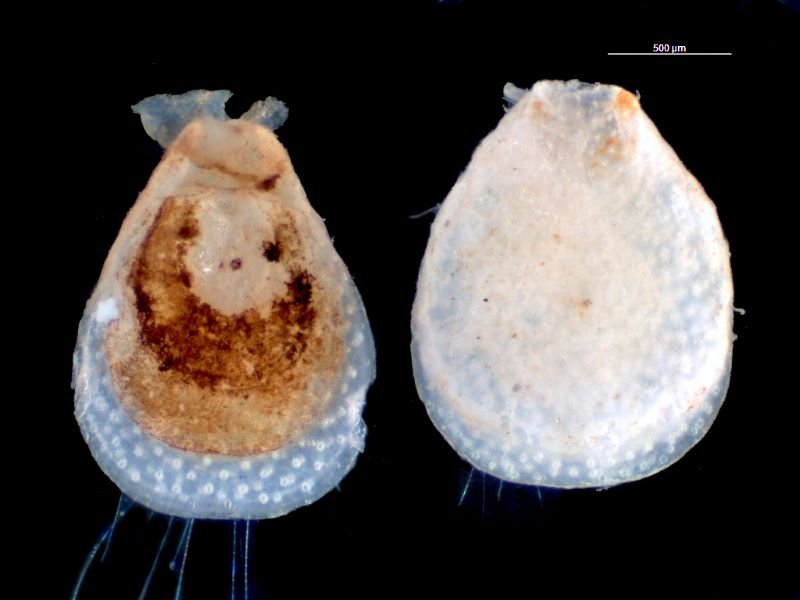
Juvenile Laqueus californianus from Elliott Bay, Puget Sound. With their little perforations, they remind me of holiday luminaries!
We’ve slipped into that special time of year here in the Pacific Northwest, when Mother Nature and daylight savings time conspire to make us feel like we dwell in darkness (or at least rainy grayness) 24 hours a day. Let’s shed a little light on the gloom with this month’s radiant critter group: the lamp shells.
An arm and a leg
Lamp shells are also known as brachiopods (from the Greek words for “arm” and “foot”). The arm refers to a delicate skeletal structure inside the shell called the brachidium, and the foot is a fleshy stalk called a pedicle that protrudes through a hole in the shells of many species, attaching the animal to the sea floor. Some species lose their pedicles as they mature, becoming free-living.
Lamplighter
Left: Laqueus californianus with pedicle hole at the bottom. Photo by Dave Cowles, wallawalla.edu. Right: Ancient Roman terra cotta oil lamp. Photo by Carole Raddato, Wikimedia Commons CC BY-SA 2.0.
Unfortunately, lamp shells can’t actually light up the night like the ancient Roman terra cotta oil lamps they resemble (although, wouldn’t that be cute?). But, they are so rarely encountered by our sediment team that their presence shines a little ray of sunshine under our microscopes.
Today, there are only about 385 species of lamp shells worldwide and they are relatively rare to find, but 600 million years ago, they were one of the most abundant filter-feeders on earth. We know this because their fossils (30,000 species of them) are prevalent all over the world. I found some on a recent trip to Utah, where an ancient, brachiopod-filled ocean once covered what is now arid desert.
This fossilized brachiopod I found in the Utah desert has a distinct sulcus, or depression, running along its larger
Bring it to light
So what happened to all the little lamps? One theory points to a mass extinction event that swept the planet around 250 million years ago, when brachiopods (and many other organisms) appear to have lost much of their diversity. Mollusks, with their faster metabolisms and stronger respiratory systems, may have been better adapted to the post-disturbance conditions, and simply outshined the lamp shells (see what I did there?) at bouncing back.
Feeling clammy
Left: brachiopod shell; Right: 2 halves of a bivalve shell. Image by Jaleigh Q. Pier, CC BY-SA 4.0.
Lamp shells may look a lot like their clam competitors, but that’s where the similarity ends. Unlike bivalves, which have two side-by-side, mirror-image shells, a brachiopod’s two shells are oriented one on top of the other, and are completely different shapes. The symmetry goes in the opposite direction, with each shell divided into two mirror-image halves.
Lamp shells have no clammy gills for filtering or clammy siphons for drawing water, food, and waste in and out of their shells. Instead, they use a specialized lophophore, a coiled, U-shaped crown of tentacles supported by the brachidium, to create currents that draw water into the open shell. Tiny hairs and sticky mucus on the lophophore trap floating food bits and pass them to the mouth. Everything that doesn’t get digested from their Thanksgiving feast goes right back out the way it came in (insert barf emoji here). Fortunately, they are able to digest almost all of what they eat!
Left: Laqueus californianus, the way it would be oriented in life. Right: Terebratalia transversa with shell open, revealing the delicate brachidium arms. Photos by Dave Cowles, wallawalla.edu.
The undesirables
Normally, this would be my segue into predation – what eats this critter? How does it avoid being eaten? But many modern brachiopods are ignored by co-occurring potential predators, leading scientists to believe that brachiopods have universal chemical defenses that make them toxic or unpalatable. In 2014, researchers at Friday Harbor Labs put this to the test using some of Puget Sound’s own brachiopod species: Terebratalia transversa and Terebratulina unguicula. They offered the brachiopods on a silver platter to sea stars, crabs, and snails. And the predators ate them – like hotcakes, and with no adverse effects. So, we know now that at least some brachiopod species are delicious AND nutritious… it just doesn’t explain why predators choose not to partake. Maybe future lamp shell studies will illuminate the reason!
Critter of the Month
Dany is a benthic taxonomist, a scientist who identifies and counts the sediment-dwelling organisms in our samples as part of our Marine Sediment Monitoring Program. We track the numbers and types of species we see to detect changes over time and understand the health of Puget Sound.
Dany shares her discoveries by bringing us a benthic Critter of the Month. These posts will give you a peek into the life of Puget Sound’s least-known inhabitants. We’ll share details on identification, habitat, life history, and the role each critter plays in the sediment community. Can't get enough benthos? See photos from our Eyes Under Puget Sound collection on Flickr.







